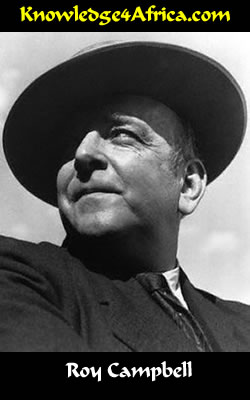|
READ THIS
In this poem, Campbell describes a Black farm labourer ploughing a field where his ancestors once fought
tribal wars. He compares the field to the man's heart, cut and torn by the insults of White people.
Campbell concludes the poem with a warning: the Black man is patiently waiting for the time when he can
destroy the institutions and way of life of the Whites.
 ABOUT THE POET
ABOUT THE POET
Roy Campbell was born in Durban in 1901 and was at one stage considered to be one of South Africa's
best poets. His popularity, however, has waned in recent years so that today his poetry is hardly ever
read.
Educated at Durban High School, he spent much of his youth in the great outdoors -- something that is
reflected in many of his poems like "The Zebras" and "Autumn". As soon as the Great War
was over, however, he moved to England where he attended Oxford University.
He married Mary Garman, a marriage which did not carry his parents' consent and therefore meant that,
for a time at least, Campbell was struck off from his inheritance. He had two daughters by this marriage.
In 1925, he returned to South Africa and founded a literary magazine called Voorslag which was
meant to promote cultural development amongst the Afrikaners whom the poet regarded as backward and
uncouth.
Very soon disillusionment set in, however, and he returned to England. His disillusionment continued even
there as he fell foul of his own fellow poets because of the many rude things he said about them in his
poems -- and even of his wife whom he found was not averse to lesbian affairs.
During the early 1930s he settled in the Provence region of France -- the scene for one of his greatest
poems, "Horses on the Camargue". During this time he was slowly drawn to Catholicism and
drunkenness.
In the mid-1930s, due to a loss in a civil lawsuit, the Campbell family fled to Spain where the poet became
an avid supporter of the fascist dictator, General Franco.
He also supported Adolph Hitler and Benito Mussolini. This support saw the poet's reputation slump even
further amongst his literary colleagues.
When World War II broke out, the poet moved back to England and enlisted for military duty. It was
during those years that he became close friends with the Welsh poet and fellow drunkard, Dylan Thomas.
After the war, the poet returned to the Iberian Peninsula but this time settled in Portugal. He died in a car
accident over the Easter weekend of 1957.
Have you looked at the questions
in the right column?
|
TEST YOURSELF!
Read the left column and then answer
the following questions:
"His naked skin clothed in the torrid mist."
- Comment on Campbell's use of the OXYMORON in "torrid mist". (5)

[Need help?]
The word "torrid" means extremely hot, parched by the sun. It also has connotations of passion
and intensity.
"Mist", on the other hand, is associated with water vapour and coolness. Campbell has used this
contrasting combination of words to describe the clouds of dust kicked up by the plough oxen.
There is also the implication that all is not as it seems: the contrast between the heat and the coolness
is a prelude to the warning that the serf's apparent patience will erupt in aggression and violence when
White rule is overthrown.
|
"Red clod, to which the war-cry once was rain
And tribal spears the fatal sheaves of corn."
- Discuss the EXTENDED METAPHOR in these two lines. (6)

[Need help?]
The war-cry of the ploughman's ancestors is compared with rain. This implies that tribal wars were a
natural part of their existence. Just as the rain brought life to the fields, so the war-cry filled them with
energy and lifted their spirits: it made them feel alive.
The tribal spears are compared with sheaves of corn, which are the harvested bundles of grain. Both
spears and grain are sharp and pointed. The sheaves represent the White people who populated and
farmed the area, causing the detribalisation of the Africans.
The reference to the tribal spears extends the metaphor of the war-cry. The war-cry and the spears
represent those things that were once meaningful to the tribes.
|
- Identify and explain the use of the TRANSFERRED EPITHET. (3)

[Need help?]
A TRANSFERRED EPITHET is when an adjective or adverb is transferred from the word which it normally
qualifies to another word. Example: He drank a cheerful glass = The man is cheerful, not the glass.
The word "fatal" refers to the deadly spears used during the tribal wars, not to the sheaves of corn.
However, if one considers that the sheaves of corn symbolise the Whites, the word "fatal" conveys
the devastating affect that detribalisation had on the Africans: they lost their culture and their tribal identity
due to White influence.
|
"His heart . . . lies fallow now."
- Discuss Campbell's effective use of METAPHOR. (5)

[Need help?]
The serf's heart is compared with a fallow field.
When a field is left to lie fallow, it is left unsown and uncultivated after having borne many crops which
depleted its fertility. By allowing the soil to rest, it is able to recuperate and rejuvenate.
The serf used to be vibrant, like the fertile field once was. Through years of insult and oppression, he
seems to have lost his energy, becoming a dejected man.
Just as a fallow field is revitalised, however, the serf is quietly building up his strength, waiting for the day
he will be able to gather his forces, return to his ancestors' former glory, and overthrow the White
oppressors. Campbell implies that this uprising is merely a matter of time.
|
"I see in the slow progress of his strides
Over the toppled clods and falling flowers,
The timeless, surly patience of the serf
That moves the nearest to the naked earth
And ploughs down palaces, and thrones, and towers."
- Account for Campbell's choice of the word "strides". Why, for instance, did he not use
"steps"? (4)

[Need help?]
"To stride" is to take long, regular steps. It implies pride, confidence and determination.
"To step", on the other hand, is simply the action of putting one foot before the other. It does not
have the same connotations as "to stride".
Campbell uses the word to convey the serf's determination and confidence in what he will achieve in the
future. He feels assured of success.
|
- Discuss the significance of the "toppled clods" and "falling flowers". (4)

[Need help?]
The words "toppled" and "falling" refer to the manner in which the White institutions will be
destroyed.
Just as the clods and the flowers are unable to resist the force of the plough, the Whites will be unable
to withstand the destructive and violent force of the uprising that will remove all signs of their existence
in Africa. Their power will be cut down just as easily as soil and flowers are turned over.
There is alliteration in "falling flowers" to emphasise this destruction.
|
- How has Campbell used the OXYMORON in the line "The timeless, surly patience of the
serf"? (3)

[Need help?]
By referring to the "surly patience" of the serf, Campbell reveals the ambiguous nature of the man.
He is unfriendly and bad-tempered, but this conceals his true nature.
His patience reflects his perseverance and his calm endurance of hardship. He is actually quietly biding
his time until he is able to overthrow the white oppressor.
|
"And ploughs down palaces, and thrones, and towers."
- Comment on Campbell's metaphorical use of "ploughs down". (4)

[Need help?]
There is a literal allusion to the serf ploughing the field, but the words have a very strong figurative
connotation. "To plough down" implies the destruction and eradication of something, using a great
deal of force.
The phrase also has implications of violence. When someone drives a car through a crowd of people,
we say that they have been ploughed down since the car acts like a plough, cutting a "furrow"
through the crowd.
Campbell uses this expression to convey the utter destruction which will take place once the serfs rise up.
There will be no stopping them. It is an uneasy reminder that the slave may well become the master.
|
Campbell has made use of ALLITERATION in this poem. Explain his reason for doing so. (3)

[Need help?]
Although there are many examples of alliteration, there is a dominance of "s" alliteration, especially
in lines 3 4, 9 10, 12 and 14. This is known as SIBILANCE. The drawn-out sound slows down the
rhythm, depicting the slow movement and the patience of the serf.
|
This poem consists of 14 lines.
- Is it a sonnet? If so, identify the type of sonnet and explain how Campbell has used the structure to
convey his message. (4)

[Need help?]
There is no rhyming couplet, so is not a Shakespearian sonnet. It is, however, divided into two parts,
suggesting an octave and sestet.
The rhyme scheme of an Italian sonnet is abbaabba, cdecde OR cdcdcd. This poem has the following
rhyme scheme: abab cdcd eefggf.
An octave consists of eight lines, but Campbell has extended the octave into line 9. The sestet starts in
line 9 with "But as the turf divides . . . . This is known as a "caesura
pause" .
In the octave, Campbell sets the scene, describing the labourer ploughing his master's fields and
compares the ploughed field with his heart, cut by the insults and oppression of the Whites.
The sestet warns that the serf is patiently awaiting the time he can overthrow the institutions and way of
life of the Whites who have oppressed him and his people.
|
|



